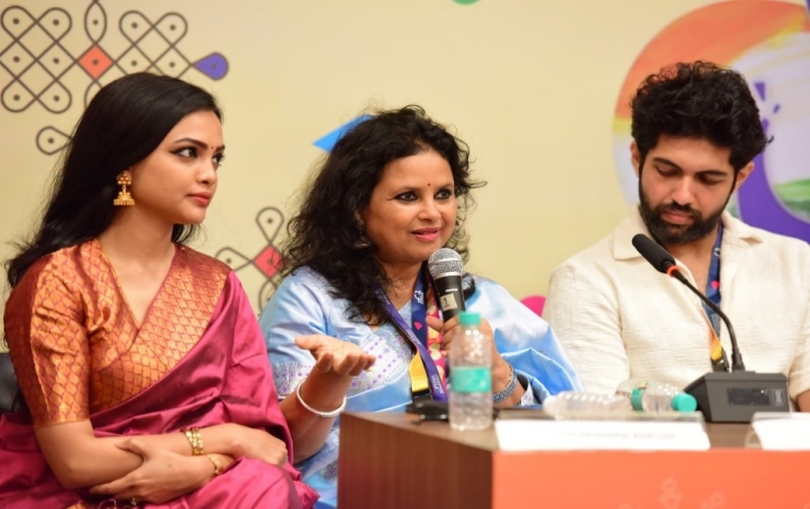IFFI 2024, 21: Karkhanu, Rador Pakhi and Google
Matrimony

IFFI 2024, 21: Karkhanu, Rador Pakhi and Google Matrimony
Karkhanu meaning Factory, was Gujarat's first Smart Horror Comedy, bringing the eerie Haunted Factory legend to life. On Kali Chaudas (part of the auspicious annual Diwali celebrations in India) night, three carpenters are trapped in a ghostly workshop, where bizarre events force them to uncover its secrets before it's too late. A thrilling mix of suspense, humour and horror.
Rador (morning sunshine) Pakhi (birds) tells the true story of Jyoti, an aspiring writer from Assam, diagnosed with Spinal Muscular Atrophy, which leaves her bedridden. Despite her physical challenges, she persists in pursuing her dream of becoming an author. The film highlights her journey, showcasing the resilience of the human spirit and the strength found in overcoming obstacles to follow one's dreams.
Google Matrimony was shown in the Indian Non-Feature Film’ category. It follows a Blind person named Ananthu, who leads a solitary life, relying on his Google Glass for sight and assistance. For those who are unfamiliar with Google Glass, here is the background of this product, which has been discontinued.
The key feature of Google Glass was the tiny semi-transparent screen located on the upper right-hand side of the glasses. This display occupied only about 5% of the wearer's natural field of vision and is responsible for transmitting information to the user.
In order to view the screen, wearers had to look up, placing the screen out of the direct line of vision. This feature is particularly important because bad placement of the display could lead to serious safety issues. It had:
- The ability to take photos and videos and then share exactly what the user is seeing through Google Hangouts.
- The option to use the Google search engine through the glasses, using Wi-Fi or a smartphone's data connection.
- The ability to have translations streamed straight to the wearer through the screen.
- Reminders to complete certain chores or tasks with an added visual aspect that will prompt a notification to appear on the user's screen every time they look at a particular object.
- The ability to sync the glasses to calendars stored on phones or computers in order to receive reminders of events and meetings.
- Support of both voice and video calls. In the video calls, wearers can show the other person exactly what they're looking at instead of talking face-to-face.
- The ability to answer emails and text messages using voice dictation.
- Collaboration with Google Maps to provide step-by-step directions with a map displayed on the screen.
- The ability to respond to facial and head movements, such as allowing the user to tilt their head to scroll through a page or operate the device with eye movements.
The final version of Google Glass, Glass Enterprise Edition 2, features a USB-C port for faster charging, an improved camera and a processing boost from its new use of Qualcomm's Snapdragon XR1 chip, which is designed specifically for augmented and virtual reality systems. The XR1 chip allows the Google Glass device to integrate advanced machine learning and computer vision abilities.
Google provides system images for Glass Enterprise Edition, and third parties are responsible for developing and maintaining apps. No software updates from Google are planned. However, the latest system images were to remain available on the System images page, and through the OTA update process, until at least April 1, 2024.The pre-installed Meet on Glass app does not receive ongoing support from Google after September 15, 2023, and the app may stop working at any time after September 15, 2023.
Back to the film. Struggling with rejection on matrimony sites due to his blindness, his world changes when his Google Glass detects a woman smiling at him, sparking romance. The film explores the search for true human connection in a tech-driven world, where reality and illusion often intertwine, and love and acceptance remain the ultimate desires.
The 55th International Film Festival of India (IFFI) showcased three exceptional films: Gujarati film, Karkhanu, Assamese film, Rador Pakhi, and Google Matrimony. Created by visionary directors and producers, these cinematic gems explore deep themes of suspense, humour, horror, the search for authentic human connection, and the strength to embrace life's challenges.

At the media interaction, Rushabh Thanki, Director of Karkhanu, shared that the film is deeply rooted in Gujarat’s folklore. Initially created as a short film, it was later expanded into a full-length feature. Actor, Parth Dave, described the film as a two-year journey, a satire, and a one-cut project that was self-financed, marking a new milestone for the Gujarati film industry with its screening at IFFI.

Google Matrimony's, Director, Shreekarthick S. S., explained that the film is part of an anthology. Filmmaker Abhinav G Atrey, mentioned that the story explores how technology impacts lives. Actor, Dev added that the team values the appreciation received at IFFI, which inspires emerging filmmakers. When asked about the film’s commercial viability, he emphasised that their focus was on creating a meaningful film rather than making money.

For the film Rador Pakhi, Director, Dr. Bobby Sharma Baruah, described the film as a sensitive portrayal of a girl with Spinal Muscular Atrophy. When asked about the film’s understated tone, she explained that it was based on a true, heartfelt story. Actress, Sulakhyana Baruah, shared that being part of ‘Rador Pakhi’ was both mentally and physically challenging, but a great honour, as she portrayed a truly inspiring real-life figure.
19